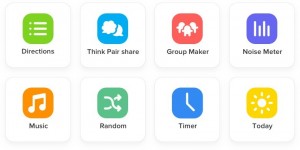How often have you lost precious planning time because you were busy communicating with parents? How about getting so caught up in lesson planing that you completely forget to get back to parents? Too many teachers face this problem daily, and I was no different. The problem was that I wanted to email so many positive messages and videos to parents, that I wouldn’t have enough time in the day to do anything else. I was tired of seeing, “File too large” or “Check permission settings” when sharing videos. That’s not fair to parents. They deserve to know exactly how their child is doing and in a timely manner. I have always taken pride in parent communication, but as a physical education teacher with over 400 students, it has been a challenge to keep families up to speed. After hearing the success it had on my colleague’s class, I tried the free app, “Class Dojo.” It has been amazing. After just three months of implementing it and using it’s wonderful resources, I don’t think I could go back to the “old school” emailing and attaching videos. Now, parents know exactly how their child is doing, and they can literally see it. Below are examples of how Class Dojo has benefited thousands of teachers, students, and families across the country.
1: Immediate communication on behavior:
With a click of a button, parents get a notification to their phone on their child’s current behavior. As an example, let’s say you having a tough day at work. All of a sudden, you get a notification on your phone from the classroom teacher stating, “Allison is being caring.” Your day just got a little better as you think of how proud you are of your child. Often, I have students go to my iPad and press the corresponding trait, which makes them proud. The act of them pressing it creates a positive, memorable moment in my class and improves the chances of repeating the desired behavior in the future.
2. Easily sharing videos of skills or activities:
If you think positive messages get families excited, wait until you see how they react to seeing a video of their child! It could be a simple five second video of a child giving a high five and nearly every parent would “like” it. Parents simply want to see their child and ensure they are safe and learning. By sharing videos of activities in class through the app that parents can see instantly, I have provided a talking point at home where parents can ask their child about activities. As an example, you could say to your child: “I saw in PE today that you played a team-building activity. Can you tell me about the purpose of it? What were some strategies your team used to be successful?” Parents are now supporting and reinforcing concepts I teach in class, such as being “principled” and “open-minded.” This enhances learning and allows students to apply concepts in multiple settings.
3. Assessment tool:

Class Dojo has a digital portfolio comprised of data and student work that can be easily accessed. Both students and parents love viewing videos and pictures in the portfolio because they can see tangible improvement in skills over time. They also note positive social interaction among classmates. One parent told me: “I feel connected. I can see progress and can better understand his grade.” Students feel a sense of accomplishment when they see their progress. It is a proud moment for students, families, and me.
4: Teacher resources:
Besides keeping parents updated on their child’s performance and behavior, it also provides many useful tools to help teachers be more efficient in the classroom. Our school is an International Baccalaureate Candidate school, and one of our learning attributes our students learn is “open-minded.” Class Dojo helps me teach that concept as it includes many resources like “random groups.” This provides an emotionally safe environment that allows all students to feel valued and  included, as it pairs up everyone immediately, rather than the same student repeatedly being left out. It’s a great way for students to practice working with different types of students, learn about different cultures, and make new friends. They quickly learn they have more in common with their classmates than they thought, and new friendships start to develop. Other tools I use regularly and project for students to see are the timer, “think, pair, share” questions, noise meter, and music. Instead of reminding students to “quiet down”, simply point at the screen and students will get the hint. Visual feedback for them goes a long way.
included, as it pairs up everyone immediately, rather than the same student repeatedly being left out. It’s a great way for students to practice working with different types of students, learn about different cultures, and make new friends. They quickly learn they have more in common with their classmates than they thought, and new friendships start to develop. Other tools I use regularly and project for students to see are the timer, “think, pair, share” questions, noise meter, and music. Instead of reminding students to “quiet down”, simply point at the screen and students will get the hint. Visual feedback for them goes a long way.
A colleague recently told me that if I don’t advocate for my students and program, who will? If I don’t communicate with families regarding the learning going on in the classroom, who will? Class Dojo has helped me connect with families in ways I never thought possible. The two questions I have for you: 1. Are you looking to bring families together and advocate for your classroom and students? 2. Are you interested in learning new tools to help your teaching be more efficient? Try Class Dojo. Did I mention that it’s free?









